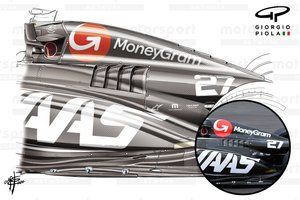What sets the Williams FW44 apart from its F1 2022 rivals so far
Williams unveiled its 2022 Formula 1 car during a shakedown at Silverstone on Tuesday following its livery reveal, and some details stand out about the FW44.

Photo by: Williams
Starting up front, the nose is much more domed than we’ve seen presented by the other teams so far, with the chassis top following a similar design.
The nose tip is connected to the second of four front wing elements, with the mainplane drooped down in the central region to help direct airflow to the underside of the nose.
The wing itself is likely a placeholder used for the car shakedown, as it’s lacking some of the detail we’ve seen on some of the other cars that have been released so far – with the exception of the diveplane which looks like it might twist more along its length than some of the other examples.
Williams has also opted to displace the front brake duct fence and wheel wake deflectors in order that they likely perform differently to how they were intended.

Alex Albon, Williams FW44
Photo by: Williams
It looks like Williams might have joined the dark side at some point too – the brake duct inlets look like Darth Vader is poking out of them to help scoop up air to help cool the brakes!
The one area of the cars that have really captured everyone’s imagination this year is how each team has come up with a different solution regarding sidepod design.
In Williams’s case, this seems quite dramatic as it appears to have added more of the cooling to the centreline of the car, which is evidenced by the much bigger, rectangular airbox and large engine cover.
In moving to a more centreline-dominant approach, which we’ve seen teams like Red Bull, AlphaTauri and Alpine adopt in recent years, it gives you more freedom in terms of sidepod design.
In that respect the FW44 follows its predecessors in creating a very short and steep sidepod that ramps down to the floor and into the engine cover bodywork as quickly as possible.
The narrow nature of the sidepods is evidenced further by the blisters used to cover the two side impact spars as they jut out from the chassis (red arrows on picture below).

Williams FW44
Photo by: Williams
Williams will use the Mercedes gearbox for the first time this season to free up resources and like Aston Martin, who also take the Mercedes gearbox, Williams has opted for a pull-rod rear suspension layout.
This would suggest we can expect the same from the works Mercedes team when we see the W13 unveiled on Friday.
The lower bodywork tapers in extremely tightly towards the car’s coke bottle region, and features the overhanging cooling outlet solution that we’ve seen elsewhere – which teams tended to favour during the V8 era.
Like Mercedes-powered counterpart McLaren, it has also opted for a single, centrally-mounted rear wing support pillar which is joined to the DRS actuator pod.
This is considered a trade-off, with the pillar weighing slightly more in order that it’s robust enough for the wing flexion tests, but provides the aerodynamic boost of only having one element interfere with the rear wing's mainplane.
Although Williams appears to have some sensors on the rear end of the floor, we can see that the ‘mouse house’ doorway that we’ve seen from the likes of Aston Martin already, also appears to feature on the FW44 (blue arrow on above picture).
This should help overcome the difficulties posed by having more extreme surface geometries in the floor and diffuser, which will improve the diffuser's edge vortex in-turn.
Be part of the Autosport community
Join the conversationShare Or Save This Story
Related video
Subscribe and access Autosport.com with your ad-blocker.
From Formula 1 to MotoGP we report straight from the paddock because we love our sport, just like you. In order to keep delivering our expert journalism, our website uses advertising. Still, we want to give you the opportunity to enjoy an ad-free and tracker-free website and to continue using your adblocker.



















Top Comments